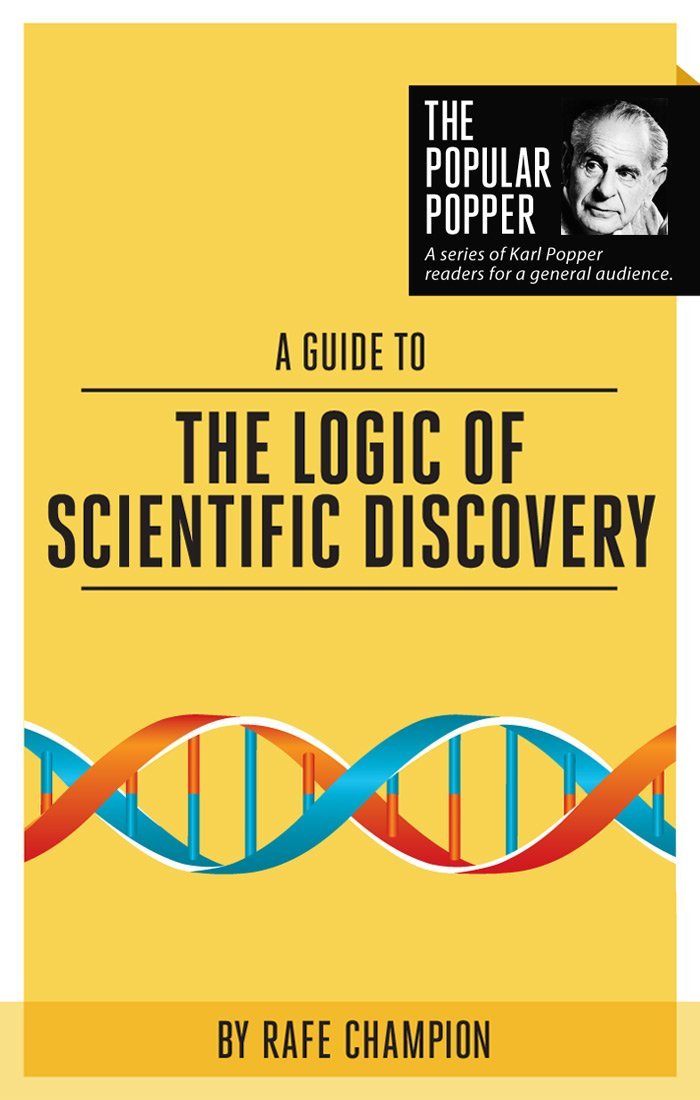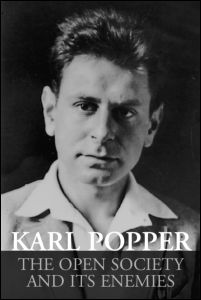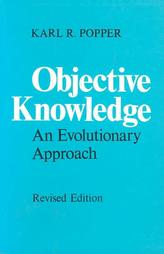This is some additional material on Postscript to The Logic of Scientific Discovery for the Popper’s Progress appendix in a revised edition of the Popular Popper series of Guides.
While Logic der Forschung was being translated during the 1950s to become The Logic of Scientific Discovery (1959) Popper wrote a lot of new notes and appendices. These grew to the point where they became a whole book which was intended to appear in 1959, titled Postscript to The Logic of Scientific Discovery: After Twenty Years ( from 1934/5 to the mid 1950s). Due to continuous revisions, other projects and a serious problem with Popper’s eyes, the publication date receded until in the late 1970s William W Bartley took on the final editing. In the meantime drafts, galley proofs and copies of the manuscript circulated among Popper’s students and colleagues at the London School of Economcs.
The Postscript finally emerged from Bartley’s editorial hands in three volumes during 1982 and 1983; Realism and the Aim of Science (Volume 1), The Open Universe: An Argument for Indeterminism (Volume 2) and Quantum Theory and the Schism in Physics (Volume 3). They contribute to Popper’s long campaign in support of realism, indeterminism and objectivism which in turn support human freedom, creativity and rationality.
The 1982 author’s Introduction to Realism and the Aim of Science responds briefly to two claims that have been frequently raised against Popper’s ideas in the three decades since the book was first written. The first is the idea that Kuhn provided a refutation or even a serious criticism of Popper’s ideas. After the launch of The Structure of Scientific Revolutions Kuhn and a deal of forceful criticism he retracted most of his interesting and radical views and adopted a more realistic position, so Popper could write “On the question of the significance of falsification for the history of science, Kuhn’s and my views coincide almost completely.” (xxxi) Kuhn himself wrote:
“Even in the developed sciences, there is an essential role for Sir Karl’s methodology. It is the strategy appropriate to those occasions when something goes wrong with normal science, when the discipline encounters crisis.” (Kuhn, 1970, 247).
A “crisis” is a situation where generally accepted theories are challenged, something that can happen at any time when scientists are alert, which is for more often than proponents of normal science realize as Firestein explained in How Ignorance Drives Science.
The second is the claim that Popper’s program was seriously undermined by the failure of his formal definition of verisimilitude. The answer is that it is often possible to demonstrate that one theory can be superior to another, that is to say nearer to the truth (in some sense, without claiming that there is some Terminus that can be eventually reached), and Popper provided two examples: the sequence of theories about the solar system from Ptolemy to Copernicus, to Kepler , to Newton and the advances in ideas about heredity from Darwin to Mendel to the double helix.
It seems that by the 1980s most philosophers had lost interest in Popper and they did not notice the decisive rejoinder to Kuhn at the start of Realism and the Aim of Science and the theory of metaphysical research programs in Quantum Theory and the Schism in Physics.
Realism and the Aim of Science has two parts, the first treats inductivism, which Popper regarded as the basis of subjectivism and idealism , and the second attacks the subjective interpretation of the probability calculus.
Popper critically reviewed four aspects of inductivism; the logical, methodological, epistemological and metaphysical. In the course of that survey he explained how his theory of falsifiability responded to some central issues in epistemology and he restated the significance of falsifiability in demarcating scientific, non-scientific, pseudoscientific and metaphysical theories from each other. He placed his ideas in the context of modern empiricism by engaging with the positions of Berkeley, Hume, Kant, Russell and Mach. He noted Bartley’s commentary on “non-justificationism” and the way that Bartley placed this in the forefront of his exegesis of Popper’s “conjectural turn” from the mainstream focus on justificationism.
The second part of Realism demonstrates a significant development of his ideas about probability from The Logic of Scientific Discovery. The thrust is the same, to attack the subjectivist interpretation of the probability calculus and the belief that probability measures a subjective degree of ignorance. In The Logic he pursued his objective interpretation of the probability calculus using the frequency interpretation but in Realism he rejected the frequency interpretation and instead proposed his own propensity interpretation. This evolved from a theory of probability to become a whole cosmology – a world of propensities!
In his editor’s foreword Bartley pointed out the deep connection between the arguments in the first and second volumes “in their mutual concern with the freedom, creativity and rationality of man”. The first addressed the way that non-justificationism (the conjectural theme) supports rationality refutes subjectivist and sceptical claims about the logical limits of criticism (hence the limits to rationality). The treatment of determinism in the second volume claims that our rationality is indeed limited with respect to the future growth of human knowledge but this is a positive and not a negative because if this limit did not exist then our exchange of arguments about our actions and policies would be meaningless (because what will be, will be, regardless of our arguments).
“Popper thus argues that human reason is unlimited with regard to criticism yet limited with regard to its powers of prediction; and shows that both the lack of limitation and the limitation are; in their respective places, necessary for human rationality to exist at all”.
The Open Universe makes a distinction between two kinds of arguments for determinism, the scientific and the metaphysical. Contrary to those who make the case for indeterminism on the basis of modern physics, Popper argues that classical physics need not presuppose or imply determinism and more than quantum physics does. The systematic nature of his thinking comes through in the connection that can be traced between subjective interpretations of probability and the way that metaphysical determinism persists in quantum physics even while the physicist may resist the scientific form of determinism.
The four chapters are “Kinds of Determinism”, “’Scientific’ Determinism”, “TheCase for Indeterminism” and”Metaphysical Issues”. The chapter on metaphysical issues describes the theory of propensities as a gain for science.
An Afterword and two especially interesting and important addenda are attached. “Indeterminism is not enough: An afterword” originally appeared in the monthly magazine Encounter in April 1973. It was the first introduction for the educated public to Popper’s new line of evolutionary thinking and the “three world” theory which he presented in a series of conference papers during the 1960s.
The first addendum is “Scientific reduction and the essential incompleteness of all science” is a rejoinder to all the over-optimistic scientists who have ever proclaimed that the “end of the road” is near, that science (usually physics) is on the verge of delivering The Final Theory About Everything. He pointed out that Godel’s incompleteness theorem of formal arithmetic provides a formal demolition of the “end of the road” aspiration, although he regarded that as “heavy argument against a comparatively weak position”. Popper’s world (of propensities) is a world of emergent evolution, emergent novelty, where problems may be solved but in the process deeper problems appear.
“Nevertheless, the method of attempting reductions is most fruitful, not only because we learn a great deal by its partial successes, by partial reductions, but also because we learn from our partial failures, from the new problems which our failures reveal.” (162)
The second addendum “Further remarks on reduction, 1981” begins with a fascinating account of the discovery of many new elements, starting with element 72, as a result of Bohr’s quantum theory of the periodic system of elements. This looked like an epic achievement in reducing chemistry to physics because the theory led to the discovery of new elements, and more than that, it led to the prediction of some of their optical properties and some properties of their chemical compounds.
“It was a great moment in the history of matter. We felt, rightly, this was it: Bohr had hit rock bottom.” (164)
But soon the dream of reduction was dashed due to work by Soddy (1910), Thomson (1913), Aston (1919).
“And then came Urey’s bombshell, the discovery of heavy water, which meant that all the basic measurements of chemistry, the measurement of the atomic weights, were slightly wrong and had to be revised. Thus the rock bottom suddenly gave way: somehow Niels Bohr had built on a morass. But his edifice still stood.” (165)
The addendum finished with a reference to Prigogine ‘s (1980) work on thermodynamics which explored the way that open systems can defy the usual understanding of the law of increasing disorder in the universe, due to the increase of entropy. It seems that some systems can export entropy into their environment and increase rather than decrease their internal order.
“Prigogine’s work may be looked upon as a piece of exciting physicalist reduction, at least in the sense that it takes the first steps towards a physical understanding of the evolution of higher structures, which seems to be a fairly obvious aspect of the evolution of life on earth. It may thus open the way to understanding the reason why the creativeness of life does not contradict the laws of physics.” (174)
The theme of the third volume of the Postscript is the way that the Copenhagen interpretation of quantum physics has been influenced by unstated and uncriticised metaphysical assumptions, especially determinism, subjectivism and instrumentalism. Of course the Copenhagen people are scientific indeterminists but Popper argues that there is a metaphysical form of determinism that they have not eliminated from their thinking.
There are four chapters after a 1982 Preface and an Introduction. The Preface makes a case for a realistic and commonsense interpretation of quantum theory to overcome the crisis in physics which Popper attributes to two things, the intrusion of subjectivism and the “end of the road” idea that quantum theory has reached the complete and final truth. In the Introduction he argues for an interpretation of quantum physics without the observer and he sharply formulated thirteen thesis to challenge the Copenhagen interpretation of the observer as an integral part of the system.
In Chapter I, ‘Understanding quantum theory and its interpretations’ Popper updated his ideas from the formulations in The Logic of Scientific Discovery. He still maintained that the problem of interpreting quantum theory is bound up with the interpretation of probability theory, and he argued that the theory of propensities that he described in the first and second volumes of the Postscript should be applied to the interpretation of quantum theory, thus resolving the difficulties that arise in the Copenhagen interpretation.
Chapter II ‘The objectivity of quantum theory’ returned to the issue of the observer in the system and confronted the doctrine that experiments have to be interpreted with the observer, and especially the consciousness of the observer, as one of the variables. The discussion includes the nature of quantum jumps and the existence or non-existence of particles.
Chapter III attempts a resolution of the paradoxes of quantum theory, using the propensity interpretation of probability, applied to (1) the indeterminacy relations, (2) the expirement of Einstein, Podolsky and Rosen, and (3) the two-slit experiment.
The long fourth chapter is the Metaphysical Epilogue. This covers a lot of ground, starting with a brief statement of the theory of metaphysical research programs (below). He then ran through a series of ten research programs. First the block universe of Parmenides, then Atomism and Geometrization, followed by Essentialism and Potentialism (from Aristotle), then Renaissance Physics (Copernicus, Bruno, Kepler, Galileo), The Clockwork Theory (Hobbes, Descartes), Dynamism (Newton), Fields of Force (Faraday, Maxwell), Unified Field Theory (Riemann, Einstein, Schrodinger) and finally The Statistical Interpretation of Quantum Theory. After a discussion of schism, programs and metaphysical dreams he went on to indeterminism and the reduction of the wave packet and a model of a universe of propensities to account for the leading features of all the ten programs that he sketched previously. After touching on some open problems he concluded with some comments on the role of metaphysical systems and the possibility of a demarcation within metaphysics, between good and bad systems.
“The proper aspiration of a metaphysician…is to gather all the true aspects of the world (and not merely its scientific aspects) into a unifying picture which may enlighten him and others, and which may one day become part of a still more comprehensive picture, a better picture, a truer picture.”
Metaphysical Research Programs
Popper’s theory of MRPs flows from his theory that we should look at the history of a subject, and its current status, in terms of its problem situations.
“In science, problem situations are the result, as a rule, of three factors. One is the discovery of an inconsistency within the ruling theory. A second is the discovery of an inconsistency between theory and experiment – the experimental falsification of the theory. The third, and perhaps the most important one, is the relation between the theory and what may be called the “metaphysical research programme”.
“By raising the problems of explanation which the theory is designed to solve, the metaphysical research programme makes it possible to judge the success of the theory as an explanation. On the other hand, the critical discussion of the theory and its results may lead to a change in the research programme (usually an unconscious change, as the programme is often held unconsciously, and taken for granted), or to its replacement by another programme. These programmes are only occasionally discussed as such: more often, they are implicit in the theories and in the attitudes and judgements of the scientists.”
“I call these research programmes “metaphysical” also because they result from general views of the structure of the world and, at the same time, from general views of the problem situation in physical cosmology. I call them “research programmes” because they incorporate, together with a view of what the most pressing problems are, a general idea of what a satisfactory solution of these problems would look like.”







Outstanding review. I’m going to rush right out and attempt to secure these three volumes, seriously – particularly the last two. Thanks.